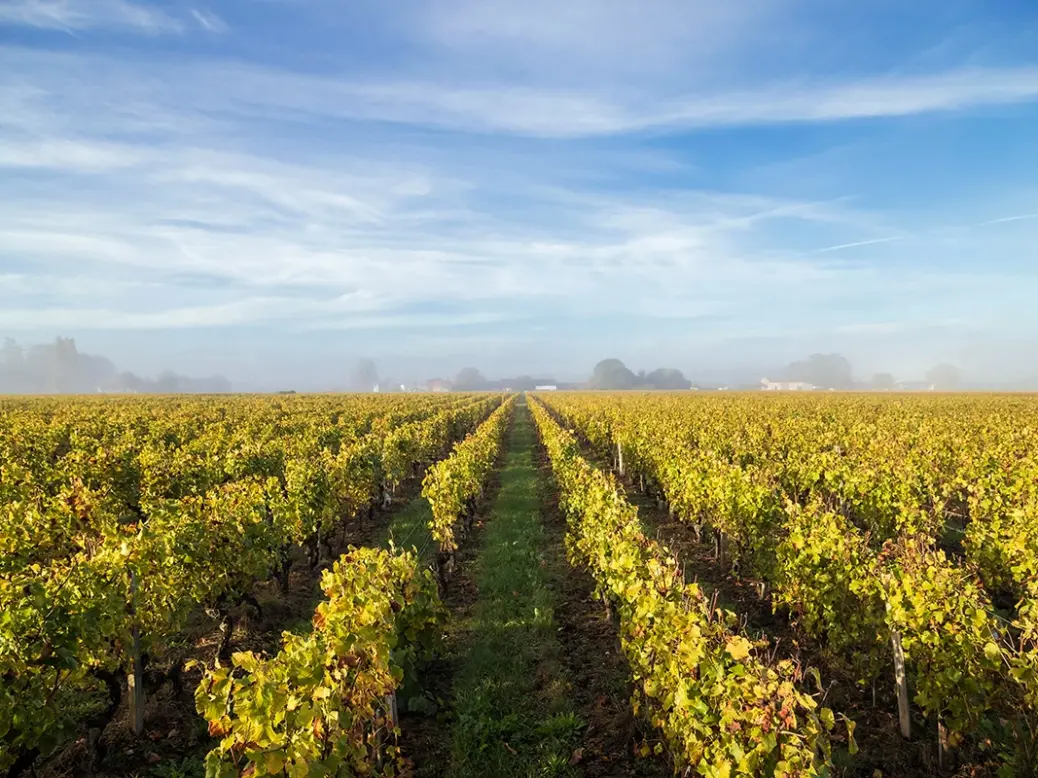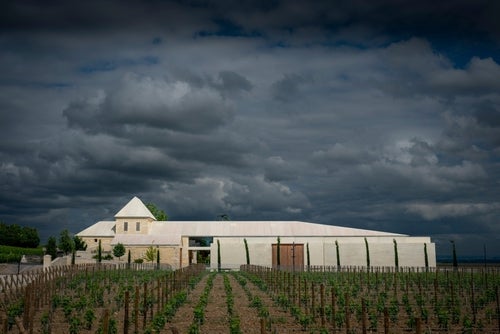
Simon Field MW’s tasting notes from the Bordeaux 2022 en primeur tastings continue with wines from Sauternes.
Bordeaux 2022: Something new under the sun—Catch 22
Bordeaux 2022 tasting notes: Left Bank part I
Château Bastor Lamontagne
(55% SB, 45% SM; 150g/l RS)A perhaps underappreciated property, firing on all cylinders at the moment. Marmalade and tarte tatin, crisp and long; a perfectly balanced Sauternes, in other words. 92–93
Château Climens 1er Cru
(100% SM; 141g/l RS)
Ten years of biodynamic accreditation provide the qualitative initiative; a corporate takeover (Bérénice Lurton is no longer here, sadly) and an aspirational approach to pricing puts this to the test with some rigor in 2022. Fortunately, technical director Frédéric Nivelle remains to pilot the ship of change. A distinctive, almost luminous amber, and distinctive aromatic of barley sugar, sour honey, and verbena; the sweetness on the palate comes as something of a surprise, but does not cloy; mandarin, apricot, and a hint of fennel. A successful wine, essential Barsac in a vintage that invited overindulgence. 94–95
Clos Haut-Peyraguey 1er Cru
(80% SM, 20% SB; 130g/l RS)
A little more Semillon than usual seems to suit the Clos Haut-Peyraguey, the small winery that looks down from the hillside onto the burgeoning Empire (hotel, Michelin-starred restaurant, etc) of its Lafaurie cousin. Not that they are related today in terms of ownership; or, come to that, in terms of style. This is a pretty example, floral, first and foremost, but also with notes of frangipane and mandarin, rapier-like acidity, and the sugar nicely integrated and not de trop. A marginally earlier harvest (and it is very marginal here) has had positive stylistic reverberations. 93–94
Château Doisy-Daëne 2ème Cru
(95% SM, 5% SB; 140g/l RS)
Even when the rain desisted, there was mist in the vineyards of Barsac, pace Jean-Jacques Dubourdieu, almost gearing up the vineyards for the rainfall and the rapid onset of near-ubiquitous botrytis and the scramble to harvest that ensued. Yields were favorable, at least compared to 2021, with 16hl/ha being 16 times more generous than its antecedent. This is quintessential Barsac, effortless and wonderfully fresh, wearing its 140g/l lightly. Deep gold, and a classic aroma of barley sugar, ginger, and dried apricot. The cold limestone soils have, albeit indirectly, nurtured a taste profile that does not stray, as others have done, into the realms of excess. Harmony, balance, and control are the watchwords here. Accordingly, it is a pleasure to take a second glass. 96–97
Château Doisy-Daëne L’Extravagant
(100% SB; 210g/l RS)
A rare and intense expression of Sauvignon Blanc, brought up in 100% of new oak; honied, rich, and viscous, this is deliberately posited antithetically to the other, more nuanced, Semillon-dominated Doisy-Daëne cuvée. Marmalade, dried apricot, barley sugar, and hint of caramel. Intensity, which, somehow, fails to cloy. It does not fail to please, for sure. The extent to which the nomenclature is justified is another matter entirely. 95–96
Bordeaux 2022 Field notes: Sauternes—ripeness is all
Château Doisy-Daëne Sec
(100% SB)
An accomplished dry white, showing off the potential of Barsac’s limestone and its self-evident affiliation with Sauvignon Blanc. An aromatic of tobacco, white peach, and agrumes is echoed on the palate, which is elegantly layered, with poised, unobtrusive acidity lending texture and freshness. 92–93
Château Doisy-Vedrines 2ème Cru
(80% SM, 20% SB; 140g/l RS)
A subtle, gently lifted wine. Classic Barsac; the 30% new oak worn lightly; such is the quiet authority of the fruit. Guillaume Lefebvre cites the fact that his property is one of the closest to the Ciron River as an explanation for the manner in which his vines coped with the hot weather. The mist was visited upon them for most mornings in September, and then, suddenly, rain and a full botrytis symphony. The healthier the grapes, the better suited they are to the malady that is botrytis, he says. I, of course, paraphrase a little, as he would never describe it as a malady. Be that as it may, the texture is impressive, the sugar worn lightly and the aromatics subtly beguiling. Guillaume very kindly also opened both 2016 and 1996, magnificent both, which, he advises, give a very encouraging pointer to the destiny of the excellent 2022. 95–96
Château de Fargues
(85% SM, 15% SB; 140g/l RS)
Deep Spanish gold, and a seductive aromatic of pâtisserie, honeycomb, and Mirabelle plum. The mid-palate is concentrated, more so than usual, but the modest alcohol and verticality thereafter steady the ship and promise an impressive evolution. Half of the normal yield (5hl/ha), mainly as a result of the spring frost, has further conspired to thicken the density of texture; hints of white pepper and marmalade chase down the finish, which is richly satisfying. So much so that one may well be better off waiting for this one, despite its immediately seductive appeal. M Mireau advises that he learned a valuable lesson in 2003 and, once the botrytis manifested itself, realized that immediate picking was the order of the day. 96% of the fruit was therefore brought in over five days of a frenetic, extended trie. The wine is matured in 40% of new wood. 95–96
Bordeaux 2022 Field notes: St-Estèphe’s northern belles
Château Lafaurie-Peyraguey 1er Cru
(95% SM, 5% SB; 200+g/l RS)
Less is definitely more chez Lafaurie-Peyraguey; not only has it reduced its vine holdings by half, maintaining the classic 1855 parcels, gravel dominating, but they have also made an incredibly rich and concentrated grand vin, yielding a modest 10hl/ha. Deep amber color, a nose of beeswax, dried apricot, and just a touch of caramel, then a palate that is big in every sense. Estate manager Vincent Cruege is almost shy to reveal the RS; we settle on 200g/l, but I suspect that it may be a notch or two higher, and I have heard some say that it actually weighs in at a surely unprecedented 260g/l! The alcohol is relatively low, at 12%; one recalls the difficulties that can be encountered fermenting powerful wines, but, miracle of miracles, the acidity is resplendent, redemptive, reassuring… an alliterative tilt to a wine that will have a lot of admirers, none of them seeking subtlety per se. It works, however. 94–95
Château Raymond-Lafon
(80% SM, 20% SB; 130g/l RS)
Geographically (and, I am told, historically) close to Yquem, but in every other respect the two could not be more different. The winery is behind the family house, with its dramatically overgrown garden and its studied air of Second Empire decadence. It is like walking onto the set of one of Chabrol’s more mysterious films. The wine is also less polished, it is safe to say, but has its own distinctive charm, the soft apricot core shrouded in almond, coconut, and pineapple. “The summer was like North Africa,” says Jean-Pierre, possibly not entirely correctly. Then, interestingly, he decided that the first trie, undertaken on September 19, was the best, thus not falling into line with many neighbors, Yquem included no doubt, who waited longer, for the more significant burst of botrytis which came a week or so later. The style of the wine is therefore lighter on its feet than some, although it does bear the hallmarks of a warm vintage, and maybe with a little more botrytis would have born more tension, with a touch more precision thereby gifted. 92–93
Bordeaux 2022 Field notes: Epoustouflant (adj)—staggering, mind-blowing
Château de Rayne Vigneau 1er Cru
(70% SM, 27% SB; 3% MUS; 150g/l RS)
A superb balance between the highly botrytic triage (two thirds) and the two earlier tries, one of which had no botrytis at all. The result refreshes and lifts on the finish but does not lack for a generous, creamy mid-palate with fig, quince, butterscotch, and apricot all falling into place impressively. There is an appealing whiff of the orange grove at the back, a spicy dénouement, and plenty of energy. An impressive effort from the long-standing technical director, Vincent Labergère. 95–96
Château de Rayne Vigneau Grand Vin Sec
(60% SB, 40% SM)
Herewith an exciting project, which director Vincent Labergère plans to bring to the market for the first time in the fall of 2023, another example of the burgeoning category of dry white wines from the enclave historically associated with sweet wine. For the moment, this humble Bordeaux Blanc is a terrific exemplar of the possibilities offered by parcels of vines with significant calcium in their soil, which, when treated to barrique-fermentation and élevage, show an exciting qualitative potential. Soft orchard fruit, a hint of vanillin, then a flinty grip and a kiss of white pepper; texturally broad but understated and supremely elegant. 93–94
Château Suduiraut 1er Cru
(100% SM; 190g/l RS)
Technical director Pierre Montégut explains that he decided to wait until late-October to harvest (October 17–27), once the late-onset botrytis had arrived, whereas many of his neighbors brought in at least some of their fruit earlier. He missed a bigger crop, for sure, but feels that his wine has benefited structurally. The yield of 7hl/ha follows the pattern of 2019 and 2020, and far exceeds the parsimonious 1hl/ha achieved last year. A richly honied, very intense example, with at least 25% more residual sugar than usual, aged in 70% new oak. Cloying? No. Uncompromising? Yes. The volatile acidity is high, the notes of apricot skin, quince, and aniseed expressive. The finish is clean, however, and sure to please many. 95–96
Château Suduiraut Pur Sémillon
(100% SM)
Only three barrels here, 50% of them new, but a fascinating insight into the dry version of the great and long-standing botrytis sibling. A smoky, oily texture shrouds the pineapple and bitter-lemon notes, the oak assertive but failing to compromise the purity of varietal expression. There is a deft touch of salinity on the finish, which refreshes. 93–94
Bordeaux 2022 Field notes: Château Cheval Blanc—odds-on favorite
Château Suduiraut Vieilles Vignes
(55% SM, 45% SB)
A single plot, co-planted, with some vines nearly half a century in age. Rich coconut exoticism, a subplot of grapefruit and beeswax, the freshness in no way compromised, and a mere 15% of new oak appearing to be the perfect solution here; not of course that there is a problem of any kind, merely a need to ensure that the terroir is not compromised. Mission accomplished. 92–93
Château La Tour Blanche 1er Cru
(80% SM, 15% SB, 22% MUS; 130g/l RS)
Only with the fourth trie did manager Miguel Aguirre feel that the optimum level of botrytis had been achieved. This took place on October 24, after a humid interval that had allowed the botrytis spores to do their worst (by which I mean best). These grapes contribute 90% to the final assemblage, the balance from the earlier tries, including the first, when there was no botrytis at all. The effect has been to nurture an elegant wine, but not at the expense of the botrytis thrust, which drives the tension. Attractive, soft fruit, a hint of vanille bourbon and agrumes, and a finish that is as savory and satisfying as one could wish for, without weighing too heavy on the constitution. A thoughtful and ultimately successful Tour Blanche. 93–94






